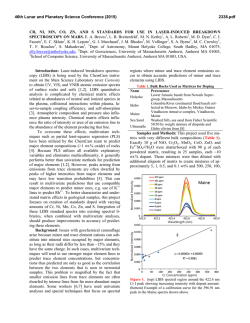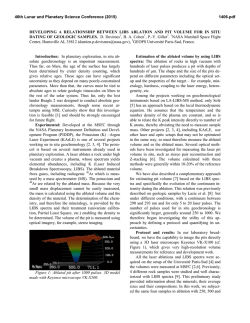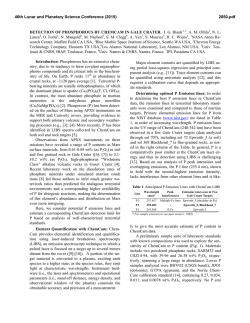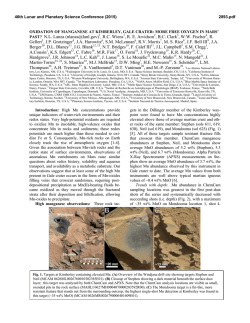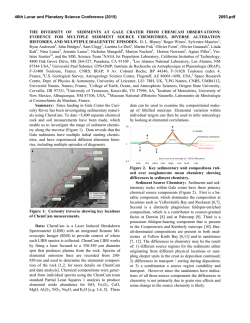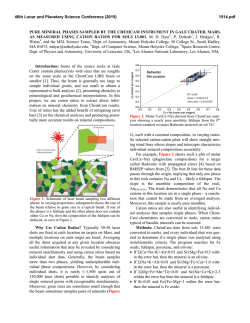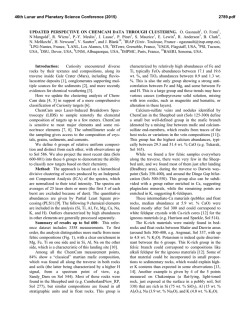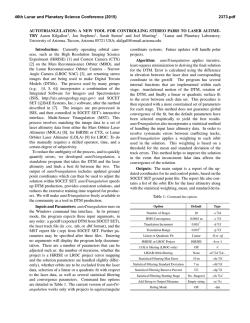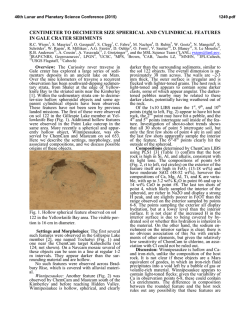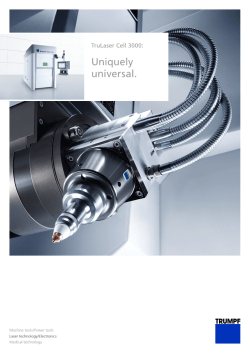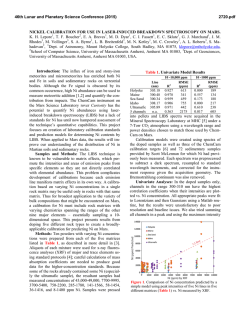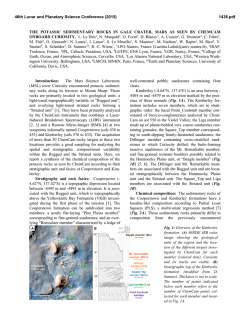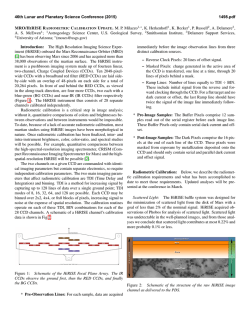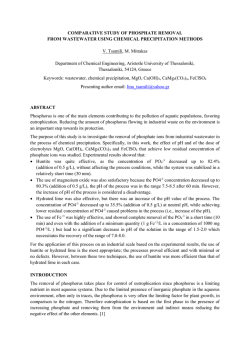
1369
46th Lunar and Planetary Science Conference (2015) 1369.pdf RELATIONSHIP BETWEEN MSL/CHEMCAM LASER FOCUS, PLASMA TEMPERATURE, AND COMPOSITIONAL CALIBRATIONS. R.L. Tokar1, R.C. Wiens2, S. Maurice3, A. Cousin3, R. Gellert4, R. B. Anderson5, S.C. Bender1, S.M. Clegg2, M.D. Dyar6, C. Fabre7, O.Forni3, O.Gasnault3, J. Lasue3 and N. Melikechi8, 1 Planetary Science Institute, 1700 E. Fort Lowell, Suite 106, Tucson, AZ, 85719-2395 ([email protected]), 2Los Alamos National Laboratory, Los Alamos, NM, 87545, 3Institut de Recherche en Astrophysique et Planetologie, Toulouse, France,4University of Guelph, ON, N1G 2W1, Canada, 5United States Geological Survey, Flagstaff, AZ, 86001, 6Mount Holyoke College, South Hadley, MA, 01075, 7University of Lorraine, Nancy, France, 8Delaware State University, Dover, DE, 19901. power density increases. Separate analysis not shown here verifies both the clear existence and the increase in the Si spectral peaks with improving focus. Goldstone SOL 830 0.8 0.75 Si II (634 nm) / Si I (288 nm) 0.7 0.65 0.6 0.55 0.5 0.45 0.4 0.35 1 2 3 4 5 6 Laser Focal Plane 7 8 9 Figure 1: Goldstone (sol 830): Si II (634.7 nm) to Si I (288.2 nm) spectra line ratio, a proxy for LIBS plasma temperature. Figure 2 illustrates for Goldstone the Mg 448 nm line variation with focal plane. The line peak area is normalized to the sum of major element peak areas. Goldstone SOL 830 0.028 0.026 0.024 Mg 448 nm The Mars Science Laboratory (MSL) ChemCam instrument uses laser induced breakdown spectroscopy (LIBS) to determine the chemical composition of rocks and soils ~2 to 7m from the Curiosity rover. ChemCam yields relatively high-precision chemical composition due to good laser stability. Lessthan-optimal laser focus results in a lower laser power density on the target, affecting the LIBS interaction and thereby the calibration of elemental compositions. On sol 801 a component of the ChemCam autofocus algorithm failed, requiring spectra be taken at multiple manual focus positions, until a new focus algorithm is uploaded. LIBS spectra taken during this intermediate time allows a careful study of the relationship between focus, which is a proxy for the LIBS plasma electron temperature, and compositional calibration. ChemCam’s detectors are not gated, so the assumption of local thermodynamic equilibrium that is usually made when determining plasma temperatures is not necessarily valid. Here the ratio of two Si emission lines: Si II (634.7 nm) to Si I (288.2 nm) is tested as a proxy for plasma temperature. The observed ratios of these emission lines for the on-board calibration targets are used to select spectra for a reduced calibration model (a “sub model”). As an example, the technique is used to calculate MgO concentration for Windjana (Mars sol 612), a relatively homogenous rock also studied in detail by the MSL APXS (Alpha Particle X-ray Spectrometer). Other oxides can be tested similarly. See [1] for calibration details of ChemCam and [2] for additional results on chemical quantification using the on-board calibration targets. First the method is validated for the rock Goldstone sampled on sol 830 in a controlled laser focus test. In this test, ChemCam data for 9 laser focal planes at a single point on Goldstone is taken with focal plane separation of ~5 mm. (Goldstone distance is ~2.25 m). There were 10 laser shots for plane 1 and 6 laser shots for planes 2-9 for a total of 58 laser shots. Figure 1 illustrates the Si line ratio for Goldstone obtained by ChemCam during the laser focus test. At each plane is plotted the mean and standard deviation for 6 laser shots (the first 4 shots for plane 1 are omitted due to dust contamination). Note the nearly linear increase in the Si ratio for the first 5 focal planes as the laser is brought into focus and the laser on-target 0.022 0.02 0.018 0.016 0.014 0.012 1 2 3 4 5 6 Laser Focal Plane 7 8 9 Figure 2: Goldstone: Observed Mg 448 nm spectral line intensity. Note the uniform increase for the first 5 focal planes with maximum intensity at the optimal focus plane 5. 46th Lunar and Planetary Science Conference (2015) 12 10 0.65 < Si634/Si288 < 0.80 0.50 < Si634/Si288 < 0.65 0.35 < Si634/Si288 < 0.50 236*Mg448 + 0.1 277*Mg448 + 0.1 313*Mg448 − 0.2 90 80 70 60 Number of Spectra To create the calibration sub models, the Si line ratios observed for Goldstone (Figure 1) are binned. For these bins, simple linear fits to the onboard calibration target known MgO composition vs. observed Mg 448 nm line intensity are obtained (Figure 3). Note that Goldstone spectra from planes 1 and 2 are in bin 1 (blue), planes 3 and 4 in bin 2 (green) and planes 5-9 in bin 3 (red). 1369.pdf 50 40 30 20 10 8 6 4 2 0 0 0.01 0.02 0.03 Mg 448 nm 0.04 0.05 0.06 Figure 3: Fits to on board calibration target known MgO composition vs observed Mg line strength. MgO composition offset slightly for clarity. Note the slopes decrease as the Si ratio increases. For constant MgO, the Mg line intensity should exhibit a corresponding increase. From the data in Figure 2 the ratio of the average Mg 448 line from bin 1 to bin 3 is 0.0232/0.0176 or 1.32 whereas the ratio of the slopes is 313/236=1.33, a nearly constant product. Specifically, MgO composition for Goldstone for the three coarse bins is 5.3, 6.3 and 5.6% for an average of 5.7% comparing favorably to the Goldstone APXS MgO of 5.74±0.17% and 6.18±0.17%. 90 0.035 0.04 Mg 448 nm Peak Area 0.045 0.05 0.055 0.61 < Si634/Si288 < 0.72 10 8 Average Windjana 6 4 2 0.01 0.02 0.03 Mg 448 nm 0.04 0.05 0.06 Figure 6: MgO sub model for Windjana Figure 6 illustrates the calibration target MgO sub model for Windjana. An estimate of MgO concentration is obtained using the average fit (red line) and the observed Mg line strength for Windjana. For MgO, average concentration is 9.0 ± 1.3 weight percent, in good agreement with APXS. It should be noted that similar techniques can be used to create partial least square (PLS) calibration sub models. References: [1] Wiens, R.C. et al. (2013) Spectrochim Acta B, 82, 1–27. [2] Fabre, C. et al. (2014) Spectrochim Acta B, 99, 34-51. 80 70 Number of Spectra 0.03 12 0 0 100 60 50 40 30 20 10 0 0.45 0.025 Figure 5: Windjana Mg 448 = 0.036 ± 0.005 Finally, this technique is applied to Windjana where APXS obtained 9.18 ± 0.25% (pre-brush) and 10.87 ± 0.25% (post-brush) for MgO weight percent. Figures 4 and 5 show histograms of the Si ratio and Mg 448 nm line strength for the 750 ChemCam laser shots on Windjana. Note the well-behaved normal distributions. MgO (%) MgO (%) 0 0.02 0.5 0.55 0.6 0.65 0.7 0.75 Si II (634.7 nm) / Si I (288.2 nm) 0.8 Figure 4: Windjana Si ratio = 0.66 ± 0.05 0.85 0.9
© Copyright 2024
